The Seven Wonders › The Colossus of Rhodes » Ancient origins
Articles and Definitions › Contents
- The Seven Wonders › Ancient History
- The Colossus of Rhodes: Enigmatic Wonder of the Ancient World › Antique Origins
Ancient civilizations › Historical and archaeological sites
The Seven Wonders › Ancient History
Definition and Origins
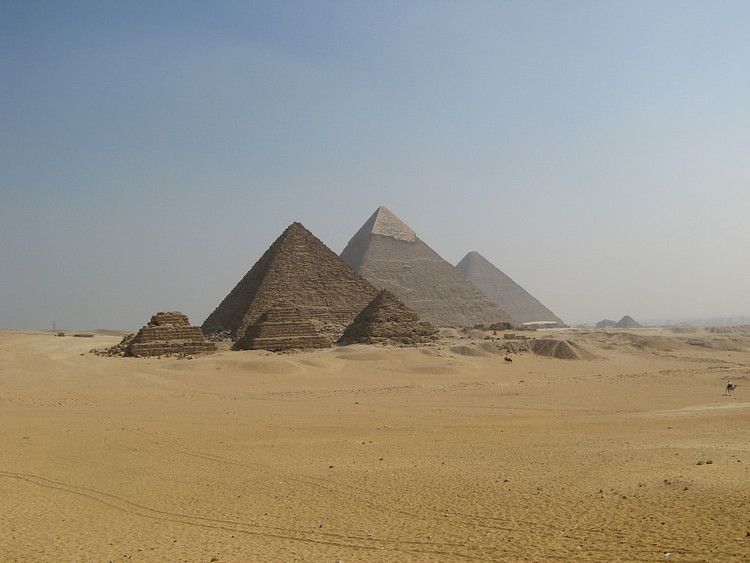
The Seven Wonders of the Ancient World were:
- the Great Pyramid at Giza, Egypt
- the Hanging Gardens of Babylon
- the Statue of Zeus at Olympia, Greece
- the Temple of Artemis at Ephesus
- the Mausoleum at Halicarnassus
- the Colossus of Rhodes
- the Lighthouse at Alexandria, Egypt
The Seven Wonders were first defined as themata ( Greek for 'things to be seen' which, in today's common English, we would phrase as 'must sees') by Philo of Byzantium in 225 BCE, in his work On The Seven Wonders. Other writers on the Seven Wonders include Herodotus, Callimachus of Cyrene and Antipater of Sidon. Of the original seven, only the Great Pyramid exists today.
GREAT PYRAMID AT GIZA
The Great Pyramid at Giza was constructed between 2584 and 2561 BCE for the Egyptian Pharaoh Khufu (known in Greek as `Cheops') and was the tallest man-made structure in the world for almost 4,000 years. Excavations of the interior of the pyramid were only initiated in earnest in the late 18th and early 19th centuries CE and so the intricacies of the interior which so intrigue modern people were unknown to the ancient writers. It was the structure itself with its perfect symmetry and imposing height which impressed ancient visitors.
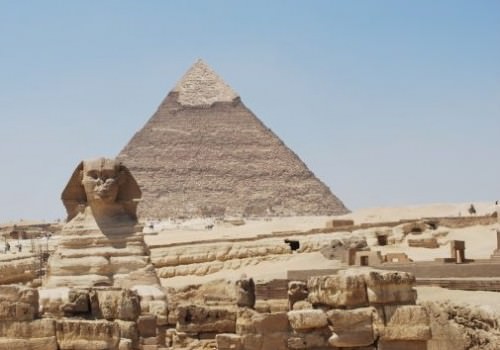
Sphinx and Khephren Pyramid
HANGING GARDENS OF BABYLON
The Hanging Gardens of Babylon, if they existed as described, were built by Nebuchadnezzar II between 605-562 BCE as a gift to his wife. They are described by the ancient writer Diodorus Siculus as being self-watering planes of exotic flora and fauna reaching a height of over 75 feet (23 metres) through a series of climbing terraces. Diodorus wrote that Nebuchadnezzar's wife, Amtis of Media, missed the mountains and flowers of her homeland and so the king commanded that a mountain be created for her in Babylon. The contoversy over whether the gardens existed comes from the fact that they are nowhere mentioned in Babylonian history and that Herodotus, `the Father of History', makes no mention of them in his descriptions of Babylon. There are many other ancient facts, figures, and places Herodotus fails to mention, however, or has been shown to be wrong about. Diodorus, Philo, and the historian Strabo all claim the gardens existed. They were destroyed by an earthquake sometime after the 1st century CE.
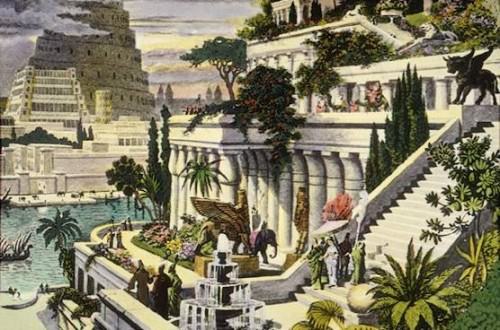
Hanging Gardens of Babylon
STATUE OF ZEUS AT OLYMPIA
The Statue of Zeus at Olympia was created by the great Greek sculptor Phidias (known as the finest sculptor of the ancient world in the 5th century BCE, he also worked on the Parthenon and the statue of Athena there in Athens ). The statue depicted the god Zeus seated on his throne, his skin of ivory and robes of hammered gold, and was 40 feet (12 m) tall, designed to inspire awe in the worshippers who came to the Temple of Zeus at Olympia. Not everyone was awestruck by the statue, however. Strabo reports, “Although the temple itself is very large, the sculptor is criticized for not having appreciated the correct proportions. He has shown Zeus seated, but with the head almost touching the ceiling, so that we have the impression that if Zeus moved to stand up he would unroof the temple” (Seven Wonders). The Temple at Olympia fell into ruin after the rise of Christianity and the ban on the Olympic Games as `pagan rites'. The statue was carried off to Constantinople where it was later destroyed, sometime in either the 5th or 6th centuries CE, by an earthquake.

Statue of Zeus, Olympia
TEMPLE OF ARTEMIS AT EPHESOS

Model of the Temple of Artemis
MAUSOLEUM OF HALICARNASSUS
The Mausoleum of Halicarnassus was the tomb of the Persian Satrap Mauslos, built in 351 BCE. Mauslos chose Halicarnassus as his capital city, and he and his beloved wife Artemisia went to great lengths to create a city whose beauty would be unmatched in the world. Mauslos died in 353 BCE and Artemisia wished to create a final resting place worthy of such a great king. Artemisia died two years after Mauslos and her ashes were entombed with his in the mausoleum ( Pliny the Elder records that the craftsmen continued work on the structure after her death, both as a tribute to their patroness and knowing the work would bring them lasting fame). The tomb was 135 feet (41 m) tall and ornately decorated with fine sculpture. It was destroyed by a series of earthquakes and lay in ruin for hundreds of years until, in 1494 CE, it was completely dismantled and used by the Knights of St. John of Malta in the building of their castle at Bodrum (where the ancient stones can still be seen today). It is from the tomb of Mauslos that the English word `mausoleum' is derived.

Lion from Mausoleum at Halicarnassos
COLOSSUS OF RHODES
The Colossus of Rhodes was a statue of the god Helios (the patron god of the island of Rhodes) constructed between 292 and 280 BCE. It stood over 110 feet (just over 33 m) high overlooking the harbor of Rhodes and, despite fanciful depictions to the contrary, stood with its legs together on a base (much like the Statue of Liberty in the harbor off New York City in the United States of America, which is modeled on the Colossus) and did not straddle the harbour. The statue was commissioned after the defeat of the invading army of Demetrius in 304 BCE. Demetrius left behind much of his siege equipment and weaponry and this was sold by the Rhodians for 300 talents (approximately 360 million US dollars) which money they used to build the Colossus. The statue stood for only 56 years before it was destroyed by an earthquake in 226 BCE. It lay in impressive ruin for over 800 years, according to Strabo, and was still a tourist attraction. Pliny the Elder claims that the fingers of the Colossus were larger than most statues of his day. According to the historian Theophanes the bronze ruins were eventually sold to “a Jewish merchant of Edessa” around 654 CE who carried them away on 900 camels to be melted down.

Ancient Rhodes by Frantisek Kupka
LIGHTHOUSE OF ALEXANDRIA
The Lighthouse at Alexandria, built on the island of Pharos, stood close to 440 feet (134 m) in height and was commissioned by Ptolemy I Soter. Construction was completed sometime around 280 BCE. The lighthouse was the third tallest human-made structure in the world (after the pyramids ) and its light (a mirror which reflected the sun's rays by day and a fire by night) could be seen as far as 35 miles out to sea. The structure rose from a square base to a middle octagonal section up to a circular top and those who saw it in its glory reported that words were inadequate to describe its beauty. The lighthouse was badly damaged in an earthquake in 956 CE, again in 1303 CE and 1323 CE and, by the year 1480 CE, it was gone. The Egyptian fort Quaitbey now stands on the site of the Pharos, built with some of the stones from the ruins of the lighthouse.
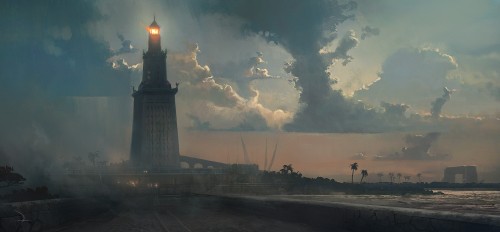
Lighthouse of Alexandria
OTHER WONDERS
The Seven Wonders of the Ancient World were, by no means, a comprehensive agreed-upon list of the most impressive structures of the day. Rather, the list was very much like a modern-day tourist pamphlet informing travelers on what to see on their trip. Those masterpieces listed above are the traditionally accepted 'wonders' as first set down by Philo of Byzantium but there were many writers who followed him who disagreed on what was a 'wonder' and what was only of passing interest.Herodotus, for example, cites the Egyptian Labyrinth as being far more impressive than even the pyramids of Giza, stating,
I visited this building and found it to surpass description; for if all the great works of the Greeks could be put together in one, they would not equal this Labyrinth. The Pyramids likewise surpass description, but the Labyrinth surpasses the Pyramids.
Nor did all agree on which of the 'wonders' was the most wonderful, as this passage from Antipater, praising the Temple of Artemis, attests:
I have gazed on the walls of impregnable Babylon along which chariots may race, and on the Zeus by the banks of the Alpheus, I have seen the hanging gardens, and the Colossus of the Helios, the great man-made mountains of the lofty pyramids, and the gigantic tomb of Mausolus; but when I saw the sacred house of Artemis, that towers to the clouds, the others were placed in the shade, for the sun himself, has never looked upon its equal, outside Olympus.
Antipater also replaced the Lighthouse with Babylon's walls and Callimachus, among others, listed the Ishtar Gate of Babylon.Philo's list, however, has long been accepted as the 'official' definition of the Seven Wonders of the Ancient World. What they all did agree on, however, was that, once upon a time, humans raised structures which were worthy of the work of the gods and, once seen, were never to be forgotten.
The Colossus of Rhodes: Enigmatic Wonder of the Ancient World › Antique Origins
Ancient Civilizations
The Colossus of Rhodes was an enormous statue depicting the city 's patron god, Helios (the god of the sun), and stood in Mandraki Harbour. Though it stood for little more than 50 years fully intact, its grand size and imposing presence at the coastal entrance of Rhodes made it an undeniable candidate as one of the Seven Wonders of the Ancient World. It is also the wonder about which the least is entirely known.

Ancient Rhodes by Frantisek Kupka
Rhodes was a Greek island that was situated at an intersection of two ancient sea-trade routes, southwest of Asia Minor and near Egypt. When Alexander the Great died unexpectedly in 323 BCE, the administration of his empire and its future were uncertain. Eventually, three of his generals took control and, as a result of several wars, divided the empire into three regions.Rhodes sided with one general, Ptolemy, who eventually controlled Egypt. Together, they forged a fruitful relationship, as well as control of trade in the eastern Mediterranean. One of the other generals, Antigonus, became riled at this, and tried to convince Rhodes to side with him. Rhodes, of course, balked at this. Antigonus then called on his son Demetrius to invade Rhodes in 305 BCE. Despite an army of 40,000 men and 200 warships, Demetrius was unable to break through Rhodes' impressive defenses and the relief troops that Ptolemy had sent in.
THE COLOSSAL STATUE WAS ERECTED TO HONOR HELIOS, THE PATRON GOD OF RHODES.
As a result of this decisive victory, it was determined that a commemorative statue be erected to honor Helios, the patron god of Rhodes. This would prove rather uncomplicated for Rhodes, as Demetrius had left behind all of the equipment he and his army had used in his invasion attempts, and thus the Rhodians were able to finance the construction of the statue with the sale of the goods.
The people of Rhodes called on Greek sculptor Chares of Lindos in 294 BCE to cast a giant bronze sculptural depiction of Helios. Over the course of 12 years, Chares and his men worked to complete the monument. It is generally agreed that it was forged around towers of stone blocks, standing 110 feet high. Helios stood on a 50-foot tall marble base, positioned at the entrance to Rhodes' harbour. Using materials that had been melted down from the weapons left by Demetrius, the stone towers were reinforced with iron beams and the bronze was attached to the shell. The finished statue would have likely depicted Helios standing with his legs together (though this theory differs from others), holding a torch in his right hand, and a spear in his left hand (very evocative of the Statue of Liberty in New York Harbour). The Colossus of Rhodes was completed in 280 BCE.
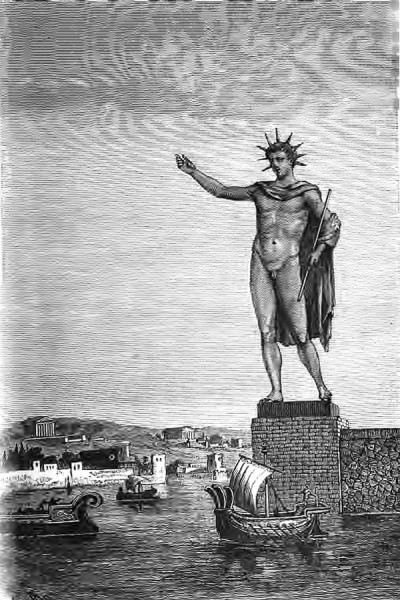
Colossus of Rhodes
When Rhodes suffered an earthquake in 224 BCE, the Colossus broke at the knees, the top portion toppling to the ground.Though Ptolemy III offered to reconstruct it, an oracle advised the Rhodians against it. Therefore, for the next 900 years the ruins of the Colossus of Rhodes lay on the ground, attracting visitors from all over the world to witness its massive scale.When the Arabs conquered Rhodes in 654 CE, the remains were broken down and transported to Syria, and likely sold piece by piece. And thus ends the story of the short-lived wonder of the ancient world, the Colossus of Rhodes. It was arguably one of the most formidable statues of ancient history, and one of the least appreciated.
LICENSE:
Article based on information obtained from these sources:with permission from the Website Ancient History Encyclopedia
Content is available under License Creative Commons: Attribution-NonCommercial-ShareAlike 3.0 Unported. CC-BY-NC-SA License